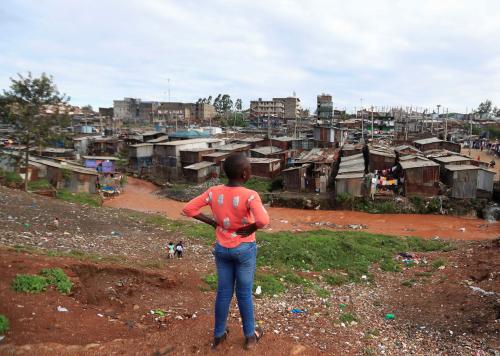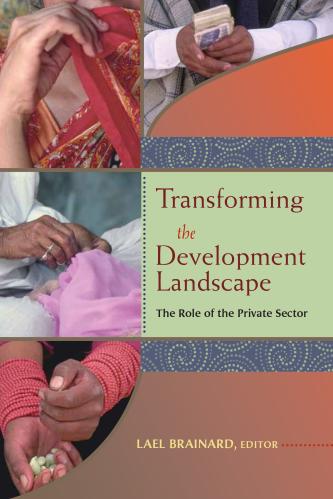Pandemic events such as COVID-19 are reminders of the need for collective investments in resilient systems that reach beyond health care. The Sustainable Development Goals (SDGs) provide both the aspiration and a unifying framework for these investments. When the first cycle of the SDGs drew to a close last fall, evaluation panels noted bright spots such as improvements in child health and education. Yet, experts conceded that gaps in measurement, investment, and shared commitment hampered progress. Then COVID-19 struck. The pandemic threatens to slow the progress on SDGs even further, combining the economic shock of a depression with rising death tolls in countries at every level of development.
Many of the priorities of SDG3 (good health and well-being) are relevant for the surge response and recovery from COVID-19. This is why the U.N. has called the pandemic “an opportunity for the human family to act in solidarity” to achieve the SDGs. So the SDGs actually provide the agenda for a sustainable global response to COVID-19—sustainable in that the response to this emergency should not lead to a neglect of the critical elements for equitable, affordable health care for all. In this blog post, we outline four opportunities for global health policy to renew the world’s commitment to the SDGs.
1. Generate momentum for universal health coverage
The premise of insurance is protection against uncertainty, yet half the world’s population lacks affordable access to essential health services. The health-poverty trap ensures that any health care event can wreak catastrophic financial devastation on uninsured people, with the cost of care driving 100 million people into extreme poverty each year.
SDG3 recognizes that we will never be capable of protecting against pandemics if populations cannot access or afford basic resources to weather the natural storms of human life. Universal health coverage (UHC) is a common destination with many paths, from Rwanda’s community-based health insurance schemes to India’s Ayushman Bharat program. Although each country is unique, decades of evidence highlight the importance of revenue raising, pooling mechanisms, data governance, and institutional accountability. Efforts to fill the knowledge gap in resource-constrained settings—such as work from the African Collaborative for Health Financing Solutions—will be critical to scale UHC efforts. Policymakers should renew their focus on UHC as a starting point to improve the health and well-being of populations around the world.
After all, the best way to prevent infections is to first inoculate against poverty. That starts with decent primary health care, so that households are not pushed into destitution by preventable illnesses.
2. Develop sustainable financing for health care innovation
Drugs require sustained investments for years before they bear fruit in the form of disease prevention and treatment. Yet funding for health innovations like vaccines is inversely related to their public health value. The emergence of public financing mechanisms (e.g., the Global Fund) and international nonprofits (e.g., Coalition for Epidemic Preparedness Innovation) has filled holes in the research and development (R&D) pipeline for global health products. Yet despite these efforts, an annual funding gap of nearly $3 billion persists.
As in the aftermath of Ebola, it is likely that funding infusions for global health R&D will follow COVID-19. But history shows that such investments are as transient as our memories of the impact of outbreaks. So we have to find ways to ensure that the response to COVID-19 is one of sustainable financing. Policymakers have many tools for financing a “global commons for health,” from international taxation mechanisms to pooled funding and strategic purchasing. The key will be securing long-term commitments insulated from politically motivated funding cuts.
But it’s about more than just funding; a sustainable response requires new thinking about both financial capital and intellectual capital. For example, patent protections have long been a barrier to access to innovation in low-resource settings. The fact that many of the proposed therapies for COVID-19 are repurposed medications has reignited conversations about the importance of flexibilities granted under the Agreement on Trade Related Aspects of Intellectual Property Rights. When the world reconvenes for a pandemic postmortem, countries need to go beyond calendar-year commitments and begin to make grants for generations.
3. Investigate the interdependencies between global health and climate change
Warmer climates can be the breeding grounds for vectors of communicable diseases that—as COVID-19 has shown—can quickly spread across the world. Recognizing the interdependencies between the two will be crucial to improving the health of communities and achieving the mission of the SDGs.
First, we have to better understand how climate change amplifies the effects of known exposures affecting population health. Consider how intimately related the public health goals of SDG3—reductions in air, water, and soil pollution— are to the climate crisis. For example, climate change can increase the prevalence of waterborne diseases, which kill half a million children each year. Likewise, runaway carbon emissions increase the burden of respiratory illness, with air pollution contributing to 200,000 annual premature deaths in the U.S. alone.
Second, the infrastructure required for health systems strengthening and climate adaptation are two sides of the same coin. For example, basic public health interventions (e.g., handwashing) are impossible in environments with high levels of water contamination. Additionally, protecting against the effects of climate change (e.g., natural disasters) requires investing in safety net systems for vulnerable populations.
While each crisis has unique challenges, policymakers can use the natural synergies between health care needs and climate change’s effects to make investments at the population level.
4. Create “compounding capacity”
It is implausible to expect countries with big gaps in health coverage, shortages in health professionals, and barriers ranging from poor transport to fake medicines to implement extreme measures such as mass testing and building field hospitals to meet the demands created by health emergencies. How then, should policymakers set public health priorities?
A promising way is to build “compounding capacity”: foundational investments that communities can build on over time to create resilient systems. For example, SDG3 calls for improving workforce training and recruitment. Community health workers have an evidence-based value-add for health care delivery and also provide an additional channel for epidemic response in both low-income and high-income countries. Likewise, developing digital capacity can improve access to care in rural regions (e.g., via telehealth) while also creating an analytical foundation for disease surveillance. Underpinning all of these delivery innovations are health financing reforms to enable frontline providers—whether treating lung failure from COVID-19 or managing a person with diabetes, cancer or kidney failure—to provide timely and convenient care.
Sustainable development as pandemic prevention
Gaps in the global response to COVID-19 should renew a sense of urgency to achieve the SDGs among policymakers worldwide. Addressing global challenges goes beyond any one country’s ability to, say, contain, trace and treat a virus. Policymakers would do well to remember the consensus in values that produced the SDGs and sustain the efforts needed to meet the promises made five years ago for bigger investments and greater international cooperation.
The Brookings Institution is committed to quality, independence, and impact.
We are supported by a diverse array of funders. In line with our values and policies, each Brookings publication represents the sole views of its author(s).












Commentary
The coronavirus is a siren for the health-related Sustainable Development Goals
May 13, 2020